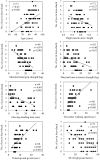Quantitative assessment of locomotive syndrome by the loco-check questionnaire in older Japanese females
- PMID: 28932003
- PMCID: PMC5599836
- DOI: 10.1589/jpts.29.1630
Quantitative assessment of locomotive syndrome by the loco-check questionnaire in older Japanese females
Abstract
[Purpose] Locomotive syndrome (LS) is a condition by which older people may require care service because of problems with locomotive organs. This study examined whether the loco-check, a 7-item questionnaire, is useful for quantitatively assessing the severity of LS. [Subjects and Methods] Seventy-one community dwelling Japanese females aged 64-96 years (81.7 ± 8.0 years) participated in this study. The associations of the loco-check with thigh muscle mass measured by X-ray CT, physical performance, nutritional status, and quality of life (QOL) were investigated. [Results] The results showed that the number of times that "yes" was selected in the loco-check was significantly correlated with thigh muscle mass, major measures of physical performance, nutritional status, and QOL. This number was also significantly larger in the participants experiencing falling, fracture, and lumbar pain than in those without these episodes. [Conclusion] These results suggest that the loco-check might be useful for quantitatively evaluating LS.
Keywords: Loco-check; Locomotive syndrome; Quantitative evaluation of frailty.
Figures
Similar articles
-
Surgery Can Improve Locomotive Syndrome Due to Lumbar Spinal Canal Stenosis and Loco-Check Can Predict Best Timing of Surgery to Avoid Progress of Locomotive Syndrome.Spine Surg Relat Res. 2021 Jun 11;6(1):58-62. doi: 10.22603/ssrr.2021-0046. eCollection 2022. Spine Surg Relat Res. 2021. PMID: 35224248 Free PMC article.
-
Association between "loco-check" and EuroQol, a comprehensive instrument for assessing health-related quality of life: a study of the Japanese general population.J Orthop Sci. 2014 Sep;19(5):786-91. doi: 10.1007/s00776-014-0602-7. Epub 2014 Jul 15. J Orthop Sci. 2014. PMID: 25023927
-
Screening program including the Loco-check and fracture risk assessment tool (FRAX®) questionnaires for assessing locomotive syndrome in a municipality in Japan: A pilot study.J Orthop Sci. 2018 Sep;23(5):819-824. doi: 10.1016/j.jos.2018.04.009. Epub 2018 Jun 28. J Orthop Sci. 2018. PMID: 30213366
-
Locomotive Syndrome and Lumbar Spine Disease: A Systematic Review.J Clin Med. 2022 Feb 27;11(5):1304. doi: 10.3390/jcm11051304. J Clin Med. 2022. PMID: 35268395 Free PMC article. Review.
-
Locomotive syndrome in Japan.Osteoporos Sarcopenia. 2018 Sep;4(3):86-94. doi: 10.1016/j.afos.2018.09.004. Epub 2018 Sep 27. Osteoporos Sarcopenia. 2018. PMID: 30775549 Free PMC article. Review.
Cited by
-
Factors predicting discharge after two years for inpatients in the psychiatric long-term care wards who can walk independently.J Phys Ther Sci. 2021 Apr;33(4):362-368. doi: 10.1589/jpts.33.362. Epub 2021 Apr 6. J Phys Ther Sci. 2021. PMID: 33935362 Free PMC article.
-
Reductions in the Frequency of Going Out Due to the COVID-19 Pandemic Negatively Affect Patients with Spinal Disorders.Spine Surg Relat Res. 2021 Sep 9;5(6):365-374. doi: 10.22603/ssrr.2021-0088. eCollection 2021. Spine Surg Relat Res. 2021. PMID: 34966862 Free PMC article.
-
Locomotive Syndrome Is Associated with Health-Related Quality of Life and Low Back Pain in the Elderly, Including Individuals More Than 80 Years Old.Prog Rehabil Med. 2020 Nov 26;5:20200029. doi: 10.2490/prm.20200029. eCollection 2020. Prog Rehabil Med. 2020. PMID: 33263091 Free PMC article.
-
Teeth loss and its association with locomotive syndrome among patients visiting the outpatient department of a dental school in Mahbubnagar, India-A cross sectional study.Acta Biomed. 2021 May 12;92(2):e2021040. doi: 10.23750/abm.v92i2.9130. Acta Biomed. 2021. PMID: 33988181 Free PMC article.
-
Surgery Can Improve Locomotive Syndrome Due to Lumbar Spinal Canal Stenosis and Loco-Check Can Predict Best Timing of Surgery to Avoid Progress of Locomotive Syndrome.Spine Surg Relat Res. 2021 Jun 11;6(1):58-62. doi: 10.22603/ssrr.2021-0046. eCollection 2022. Spine Surg Relat Res. 2021. PMID: 35224248 Free PMC article.
References
-
- Government of Japan: Cabinet office. Annual report on the aging society FY 2014. http://www8.cao.go.jp/kourei/english/annualreport/2014/2014pdf_e.html
-
- Sasaki E, Ishibashi Y, Tsuda E, et al. : Evaluation of locomotive disability using loco-check: a cross-sectional study in the Japanese general population. J Orthop Sci, 2013, 18: 121–129. - PubMed
-
- Seichi A, Hoshino Y, Doi T, et al. : Development of a screening tool for risk of locomotive syndrome in the elderly: the 25-question Geriatric Locomotive Function Scale. J Orthop Sci, 2012, 17: 163–172. - PubMed
LinkOut - more resources
Full Text Sources
Other Literature Sources

